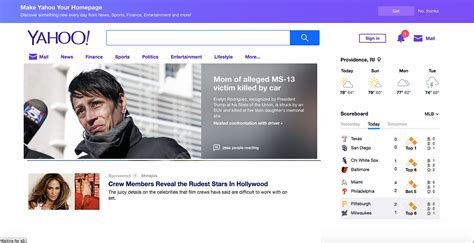Did Bad UX killed Yahoo? How UX can shape market trajectories
In the early 2000s, Yahoo held a significant position in the search engine market, commanding approximately 36.4% of U.S. searches in 2005. By 2017, when Verizon acquired Yahoo, its global search market share had dwindled to around 4%. In contrast, Google, which had about 35% of the U.S. search market in 2005, expanded its dominance to over 87% globally by 2017. This reality show us the critical role of user experience (UX) strategies in shaping market trajectories.
Yahoo's Core Audience
Yahoo's core audience, primarily urban North Americans aged 35-54 with middle to upper-middle-class incomes, valued reliability and comprehensive online services. Attrition occurred as Yahoo's cluttered interface, inconsistent design across services, and ad-heavy environment frustrated users and eroded trust, driving them toward simpler, more user-focused alternatives.
Understanding your core audience is critical because they form the foundation of your brand's success. When businesses lose focus on their primary users to chase broader appeal or new trends, they risk alienating loyal customers who sustain their growth. A misstep in catering to their needs or introducing changes that conflict with their expectations can lead to attrition, eroding trust and market share. Staying attuned to your core audience ensures stability and loyalty, providing a strong base from which to innovate or expand.
The Importance of User Experience in Marketplace Identity
In today's digital landscape, user experience (UX) is more than just a design concept; it's a critical component of a company's marketplace identity. A streamlined, intuitive UX not only attracts and retains customers but also defines a brand's position in the market. When companies lose sight of their core audience and fail to prioritize UX, they risk alienating users and undermining their market presence.
Yahoo's Misstep: From Core Audience to Clutter
Yahoo serves as a cautionary tale of how deviating from a core audience can lead to a loss of identity and customer attrition. Initially, Yahoo thrived by offering a suite of internet services. However, in its attempt to pivot into a media company, Yahoo's platform became cluttered and unfocused. This shift away from their core services confused users, leading to attrition and diminishing Yahoo's once-strong market position.
Yahoo's product development approach involved different teams working independently on various services like Mail, Finance, News, and more. Each team designed their product in isolation, leading to a lack of cohesive interaction patterns, visual consistency, or unified navigation. Users often encountered drastically different interfaces when switching between Yahoo services, creating a fragmented and frustrating experience. This siloed approach meant there was no overarching design framework to guide product development or ensure consistency across the ecosystem.
Google's design philosophy has always prioritized simplicity, speed, and user-centricity. From its inception, the company emphasized clean interfaces and intuitive interactions, ensuring users could access information efficiently. This philosophy laid the groundwork for Google’s success across its suite of products.
Material Design, launched in June 2014, formalized and expanded on this approach. It introduced a unified set of guidelines to ensure consistency across Google’s products and platforms. Material Design leveraged principles like responsive animations, tactile surfaces, and meaningful use of depth to create intuitive and visually cohesive user experiences.
By building on its existing design philosophy, Google ensured that Material Design wasn’t just a rebranding effort but a natural evolution of its longstanding commitment to seamless and efficient user interaction.
UX Design Philosophy
Yahoo: In the mid-2000s, Yahoo's homepage became cluttered with news, ads, and diverse content. This shift away from a streamlined portal confused users. Interaction patterns became inconsistent, with dense navigation and competing visual elements.
Google: Since its inception, Google's homepage has remained minimalistic. A single search bar and sparse links create a focused user journey. This design consistency reinforces ease of use.
2. Consistency and Integration
Yahoo: Lacked a cohesive experience across services like Mail, Finance, and News. Each had a different interface, leading to a disjointed UX.
Google: Seamless integration across products, such as Gmail, Drive, and Calendar, offers a unified experience. Consistent interaction patterns and visual design strengthen brand identity.
3. User-Centric Approach
Yahoo: Prioritized ad revenue and media content over user needs, leading to intrusive ads and a cluttered experience.
Google: Maintains a user-first philosophy. Features like ad labels and prioritized search relevance and minimized distractions, enhancing user satisfaction.
4. Adaptability and Innovation
Yahoo: Struggled to innovate, with slow responses to market trends like personalized content and social integration. Yahoo Live, a video platform, was launched in 2008 but failed to gain traction.
Google: Consistently innovates, introducing features like personalized search results and predictive text. Google's Material Design, launched in 2014, offers a unified design language across apps, enhancing UX.
5. Marketplace Impact
Yahoo: User attrition due to a lack of focus and cluttered UX led to a decline in market relevance. By 2017, Yahoo was acquired by Verizon, marking the end of an era.
Google: Maintained a strong marketplace identity through a consistent UX strategy. Its market share in search remains dominant, hovering around 90% globally as of 2021.
In the competitive digital landscape, UX isn’t just a design element; it’s a strategic advantage. A superior UX not only retains users but also builds trust, drives engagement, and solidifies a brand’s position in the market. Yahoo’s failure to evolve and Google's dominance remind us that a clear, user-focused vision is essential to thrive in any industry.
